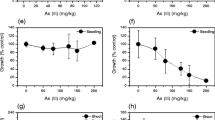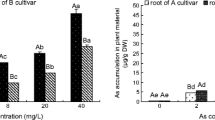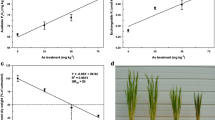Abstract
The response of maize (Zea mays L.) to inorganic arsenic exposure was studied, at the seedling stage under hydroponic conditions, preliminarily in sixteen lines (fourteen hybrids and two inbred lines) and then, more deeply, in six of these lines, selected by showing contrasting differences in their sensitivity to the metalloid. The results indicated that (i) maize is rather tolerant to arsenic toxicity, (ii) arsenite is more phytotoxic than arsenate, (iii) roots are less sensitive than shoots to the metalloid, (iv) a great accumulation of non-protein thiols (probably phytochelatins), without substantial effect on the glutathione content, is produced in roots but not in shoots of arsenic-exposed plants and (v) maize is able to accumulate high levels of arsenic in roots with very low translocation to shoots. The study, thus, suggests that maize, for its very low rate of acropetal transport of arsenic from roots to shoots, may be a safe crop in relation to the risk of entry of metalloid in the food chain and, for being an important bioenergy crop capable of expressing high levels of arsenic tolerance and accumulation in roots, may represent an interesting opportunity for the exploitation of agricultural useless arsenic contaminated lands.



Similar content being viewed by others
Abbreviations
- As(V):
-
Arsenate
- As(III):
-
Arsenite
- DTNB:
-
5,5′-Dithiobis(2-nitrobenzoic acid)
- DW:
-
Dry weight
- EC50 :
-
Effective concentration that inhibits plant growth by 50 %
- FW:
-
Fresh weight
- GSH:
-
Reduced glutathione
- GSSG:
-
Oxidized glutathione
- iAs:
-
Inorganic arsenic
- NPTs:
-
Non-protein thiols
- ONPTs:
-
Other non-protein thiols different to GSH
- PCs:
-
Phytochelatins
- RAI:
-
Root absorption index
- RTI STI and WPTI:
-
Root, shoot and whole-plant tolerance index, respectively
References
Abedin MJ, Meharg AA (2002) Relative toxicity of arsenite and arsenate on germination and early seedling growth of rice (Oryza sativa L.). Plant Soil 243:57–66
Abedin MJ, Cotter-Howells J, Meharg AA (2002) Arsenic uptake and accumulation in rice (Oryza sativa L.) irrigated with contaminated water. Plant Soil 240:311–319
Ahsan N, Lee DG, Alam IA, Kim PJ, Lee JJ, Ahn YO, Kwak SS, Lee IJ, Bahk JD, Kang KY, Renaut J, Komatsu S, Lee BH (2008) Comparative proteomic study of arsenic-induced differentially expressed proteins in rice roots reveals glutathione plays a central role during As stress. Proteomics 8:3561–3576
Anderson ME (1985) Determination of glutathione and glutathione disulfide in biological samples. Methods Enzymol 113:548–554
Anderson MD, Prasad TK, Stewart CR (1995) Changes in isozyme profiles of catalase, peroxidase, and glutathione reductase during acclimation to chilling in mesocotyls of maize seedlings. Plant Physiol 109:1247–1257
Carbonell-Barrachina AA, Aarabi MA, DeLaune RD, Gambrell RP, Patrick WH Jr (1998) The influence of arsenic chemical form and concentration on Spartina patens and Spartina alterniflora growth and tissue arsenic concentration. Plant Soil 198:33–43
Ci XK, Liu HL, Hao YB, Zhang JW, Liu P, Dong ST (2012) Arsenic distribution, species, and its effect on maize growth treated with arsenate. J Integr Agric 11:416–423
Cullen WR, Reimer KJ (1989) Arsenic speciation in the environment. Chem Rev 89:713–764
De Vos CHR, Vonk MJ, Vooijs R, Schat H (1992) Glutathione depletion due to copper-induced phytochelatin synthesis causes oxidative stress in Silene cucubalus. Plant Physiol 98:853–858
Dhankher OP (2005) Arsenic metabolism in plants: an inside story. New Phytol 168:503–505
Drlicková G, Vaculík M, Matejkovic P, Lux A (2013) Bioavailability and toxicity of arsenic in maize (Zea mays L.) grown in contaminated soils. Bull Environ Contam Toxicol 91:235–239
Gong JM, Lee DA, Schroeder JI (2003) Long-distance root-to-shoot transport of phytochelatin and cadmium. Proc Natl Acad Sci U S A 100:10118–10123
Griffith OW (1980) Determination of glutathione and glutathione disulfide using glutathione reductase and 2-vinylpyridine. Anal Biochem 106:207–212
Gulz PA, Gupta SK, Schulin R (2005) Arsenic accumulation of common plants from contaminated soils. Plant Soil 272:337–347
Kocsy G, von Ballmoos P, Suter M, Rüegsegger A, Galli U, Szalai G, Galiba G, Brunold C (2000) Inhibition of glutathione synthesis reduces chilling tolerance in maize. Planta 211:528–536
Kocsy G, von Ballmoos P, Rüegsegger A, Szalai G, Galiba G, Brunold C (2001) Increasing the glutathione content in a chilling-sensitive maize genotype using safeners increased protection against chilling-induced injury. Plant Physiol 127:1147–1156
Liu ZH, Li WH, Qi HY, Song GL, Ding D, Fu ZY, Liu JB, Tang JH (2012) Arsenic accumulation and distribution in the tissues of inbred lines in maize (Zea mays L.). Genet Res Crop Evol 59:1705–1711
Lubin JH, Beane Freeman LE, Cantor KP (2007) Inorganic arsenic in drinking water: an evolving public health concern. J Natl Cancer Inst 99:906–907
Marin AR, Masscheleyn PH, Patrick WH Jr (1992) The influence of chemical form and concentration of arsenic on rice growth and tissue arsenic concentration. Plant Soil 139:175–183
McGrath SP, Zhao FJ, Lombi E (2002) Phytoremediation of metals, metalloids, and radionuclides. Adv Agron 75:1–56
Pickering IJ, Prince RC, George MJ, Smith RD, George GN, Salt DE (2000) Reduction and coordination of arsenic in Indian mustard. Plant Physiol 122:1171–1177
Pinhero RG, Rao MV, Paliyath G, Murr DP, Fletcher RA (1997) Changes in activities of antioxidant enzymes and their relationship to genetic and paclobutrazol-induced chilling tolerance of maize seedlings. Plant Physiol 114:695–704
Porter EK, Peterson PJ (1977) Arsenic tolerance in grasses growing on mine waste. Environ Pollut 14:255–265
Raab A, Feldmann J, Meharg AA (2005) Uptake, translocation and transformation of arsenate and arsenite in sunflower (Helianthus annus): formation of arsenic-phytochelatin complexes during exposure to high arsenic concentrations. New Phytol 168:551–558
Rahman MA, Hsegawa H, Rahman MM, Islam MN, Miah MAM, Tasmen A (2007) Effect of arsenic on photosynthesis, growth and yield of five widely cultivated rice (Oryza sativa L.) varieties in Bangladesh. Chemosphere 67:1072–1079
Requejo R, Tena M (2005) Proteome analysis of maize roots reveals that oxidative stress is a main contributing factor to plant arsenic toxicity. Phytochemistry 66:1519–1528
Requejo R, Tena M (2012) Influence of glutathione chemical effectors in the response of maize to arsenic exposure. J Plant Physiol 169:649–653
Salt DE, Smith RD, Raskin I (1998) Phytoremediation. Annu Rev Plant Physiol Plant Mol Biol 49:643–668
Schat H, Llugany M, Vooijs R, Hartley-Whitaker J, Bleeker PM (2002) The role of phytochelatins in constitutive and adaptive heavy metal tolerances in hyperaccumulator and non-hyperaccumulator metallophytes. J Exp Bot 53:2381–2392
Schmöger MEV, Oven M, Grill E (2000) Detoxification of arsenic by phytochelatins in plants. Plant Physiol 122:793–801
Schröder P, Herzig R, Bojinov B, Ruttens A, Nehnevajova E, Stamatiadis S, Memon A, Vassilev A, Caviezel M, Vangronsveld J (2008) Bioenergy to save the world – Producing novel energy plants for growth on abandoned land. Environ Sci Pollut Res 15:196–204
Schulz H, Härtling S, Tanneberg H (2008) The identification and quantification of arsenic-induced phytochelatins – comparison between plants with varying As sensitivities. Plant Soil 303:275–287
Smith E, Naidu R, Alston AM (1998) Arsenic in the soil environment: a review. Adv Agron 64:149–195
Sneller FEC, Van Heerwaarden LM, Kraaijeveld-Smit FJL, Ten Bookum WM, Koevoets PLM, Schat H, Verkleij JAC (1999) Toxicity of arsenate in Silene vulgaris, accumulation and degradation of arsenate-induced phytochelatins. New Phytol 144:223–232
Stoeva N, Berova M, Zlatev Z (2003) Physiological response of maize to arsenic contamination. Biol Plant 47:449–452
Vázquez S, Esteban E, Goldsbrough P (2005) Arsenate-induced phytochelatins in white lupin: influence of phosphate status. Physiol Plant 124:42–50
Wang J, Zhao FJ, Meharg AA, Raab A, Feldmann J, McGrath SP (2002) The role of phytochelatins in arsenic tolerance in the hyperaccumulator Pteris vittata. Plant Physiol 130:1552–1561
Williams PN, Villada A, Deacon C, Raab A, Figuerola J, Green AJ, Feldman J, Meharg AA (2007) Greatly enhanced arsenic shoot assimilation in rice leads to elevated grain levels compared to wheat and barley. Environ Sci Technol 41:6854–6859
Zhao FJ, Ma JF, Meharg AA, McGrath SP (2009) Arsenic uptake and metabolism in plants. New Phytol 181:777–794
Acknowledgments
This research has been supported by the Spanish Science and Technology Ministry (Project REN2003-03843/TECNO) and Andalusia (Spain) Regional Government (PAI Group AGR 164). The authors thank Alberto Ojembarrena (Pioneer Hi-Bred Spain) and Cindy Leveque (Pioneer Génétique France), and Prof Peter Stamp and Dr Jörg Leipner (Institute for Plant Sciences, ETH Zürich) for providing seeds of the maize hybrids and inbred lines, respectively.
Author information
Authors and Affiliations
Corresponding author
Additional information
Responsible editor: Elena Maestri
Rights and permissions
About this article
Cite this article
Requejo, R., Tena, M. Intra-specific variability in the response of maize to arsenic exposure. Environ Sci Pollut Res 21, 10574–10582 (2014). https://doi.org/10.1007/s11356-014-3097-z
Received:
Accepted:
Published:
Issue Date:
DOI: https://doi.org/10.1007/s11356-014-3097-z




